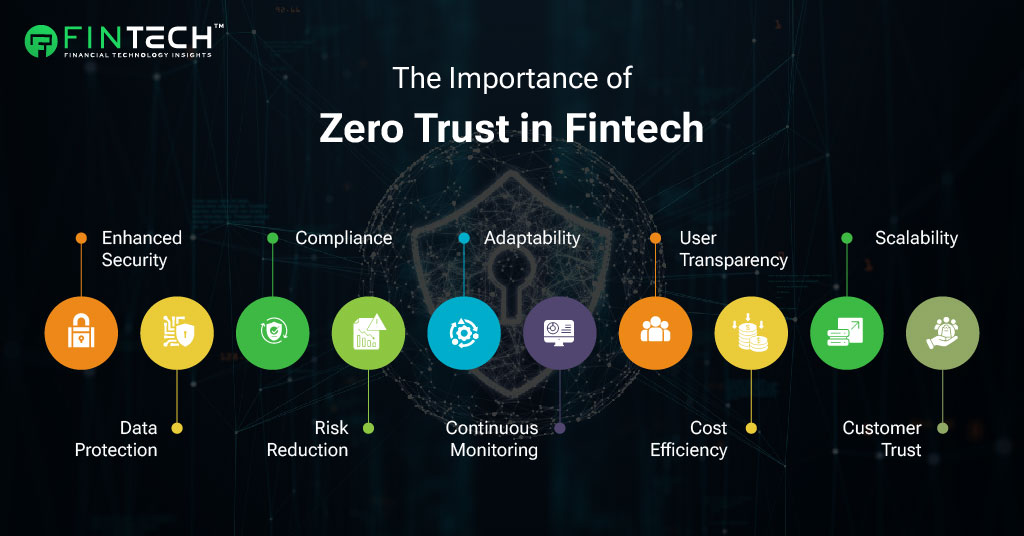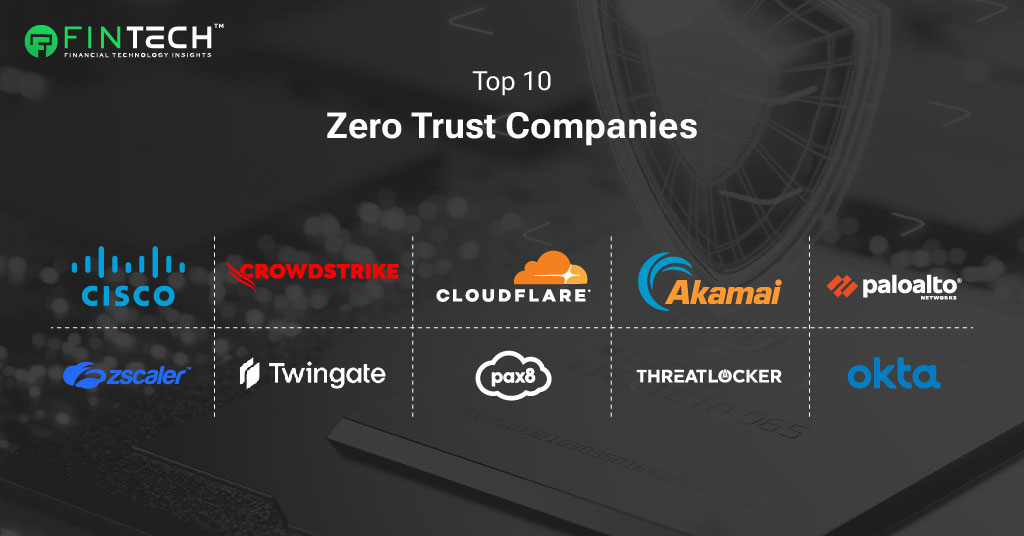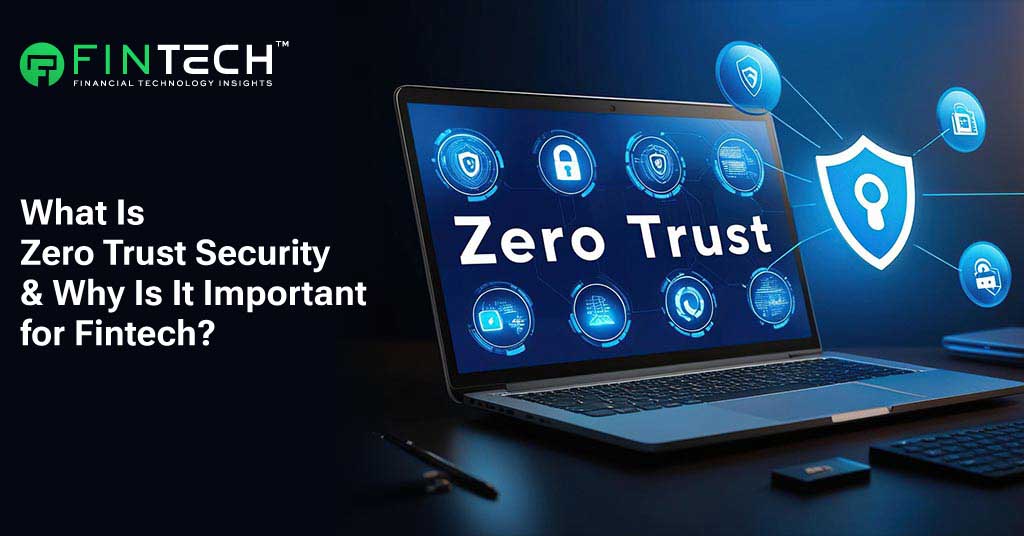What Is Zero Trust Security and Why Is It Important for Fintech?
John Kindervag introduced the term “Zero Trust” in 2010, recognizing the absurdity of a security approach that was perimeter-based. For many years, businesses have employed conventional and inadequate methods to gain access to their data and applications. This approach implies that all individuals within the organization are unconditionally trusted. The employee or laborer may acquire access to the company’s data solely by virtue of their employment with the indicated organization. Any individual who is not affiliated with the organization is considered suspicious; however, the individual who is inside capitalizes on the uncertainty. This conventional approach has resulted in a multitude of security violations and the establishment of implicit trust within the inner circle. It permits only external parties to obtain access to the organization’s operations by crossing the perimeter.

The Zero Trust model recognizes that it is impossible to distinguish between the “good guys” and the “bad guys.” The establishment of a robust perimeter is no longer sufficient due to the proliferation of cloud services and hybrid workplaces, which creates a challenge for security. The model adheres to the “never trust, always verify” principle and conducts identity verification and authentication on each user at multiple stages. It is not a believer in trusting any individual, as the name implies, and permits access to all data only after verification of the individual.
Zero Trust security is a model that regards every individual with suspicion, regardless of whether they are an insider or an interloper. It is a multi-layered security system that grants users access based on their identity and role. The zero trust model eliminates the binary condition of the insider employee receiving the benefit of the doubt, regardless of whether the individual is working remotely or at the office. This model consistently requests authorization and authentication at multiple locations throughout the network, rather than solely at the perimeter.
Fintech will benefit from a zero-trust environment:
- Enhance the security of remote access and enable work-from-anywhere and BYOD-heavy environments in a secure manner.
- Mitigate the risk of ransomware, malware, and other types of threats.
- Regardless of the source, access to the document is necessary to verify that the activity was appropriate.
- Ensure that the authentication process between B2B is more reliable and seamless. For example, a foreign organization is granted privileges by a single organization without the necessity of implementing its directory services.
Read: Fintech Marketing: Top 10 Power Strategies to Accelerate Growth
Six Stages to the Implementation of Zero-Trust Principles in Banking
In the context of financial services, ZTA entails a sequence of strategic measures that are designed to improve the security and resilience of banking operations. The majority of organizations should endeavor to adhere to a ZTA implementation framework that includes the subsequent steps:
- Conducting a Network Analysis.
The organization should create a comprehensive map of all data flows, digital materials, and banking services. This phase is critical for the identification of potential vulnerabilities that could be exploited by cybercriminals. In a banking environment that encompasses numerous, interconnected systems and platforms, this phase is of paramount importance.
- Establishing Access Control and Permissions for Each User Role.
In a banking environment, user roles may encompass a wide variety of positions, including executives, system administrators, and customer service representatives. ZTA adheres to the principle of least privilege, which stipulates that users should only be granted access to the resources necessary to fulfill their employment responsibilities.
- The Implementation of Multifactor Authentication.
MFA is a critical element of ZTA because it necessitates users to submit multiple forms of identification prior to gaining access to the network.
- Choosing the Most Suitable Zta Solutions.
ZTA solutions and features should be chosen by financial services organizations in accordance with their organizational structure, complexity, and individual requirements. For example, banks require a solution that facilitates micro-segmentation, which divides the network into smaller, isolated segments and reduces the potential impact of a security incident by containing it within a segment. This capability is particularly advantageous for financial institutions, as distinct operational divisions may encounter distinct inherent hazards.
- Conducting Continuous Surveillance and Adaptation.
The implementation of ZTA is not a singular event. In order to maintain the security of the system as the organization develops, ongoing monitoring and adaptation are necessary for a successful implementation. The identification of unusual network behavior and the evaluation of the influence of the ZTA measures on banking operations can be facilitated by consistent reporting.
- Implementation of Personnel Education and Training.
It is probable that the implementation of ZTA will necessitate modifications to the manner in which users interact with and access the system. In order to comprehend these modifications and adhere to the new security protocols, users will require instruction and instruction. Users may resist the transition to a zero-trust approach if the changes lead to a more complex or inconvenient user experience.
Read More Fintech Insights: Fintech Marketing: Top 10 Power Strategies to Accelerate Growth
Top 10 Zero Trust Companies

1. Cisco Zero
The solutions are designed to provide a comprehensive view of the business and to utilize sophisticated security analytics to promptly identify and resolve potential attacks. In particular, the Cisco Zero Trust Architecture (ZTA) is designed to establish user and device trust by securing every access point across applications and monitoring access attempts, as well as implementing application-specific security policies.
CrowdStrike’s Zero Trust solution is designed to protect businesses from contemporary cyber assaults by utilizing one of the world’s largest unified threat-centric data fabrics to prevent breaches in real time. The organization’s objective is to assist businesses in identifying all managed and unmanaged endpoints that may affect their security posture, thereby facilitating a Zero Trust journey that is both scalable and adaptable.
3. CloudFlare
The Zero Trust services offered by CloudFlare encompass the prevention of data loss, malware, and phishing through the use of Internet browsing solutions, such as Secure Web Gateway (SWG), browser isolation, email security, and cloud access security broker. Its services enable the monitoring and management of SaaS applications to prevent data breaches.
Revenue of US$3.6 billion annually in 2022
Akamai Connected Cloud spans 790+ cities and employs over 9,800 individuals globally.
Akamai’s objective is to assist businesses in the development of edge computing solutions that are customized to meet their unique growth and development requirements. The company’s periphery compute platform is instrumental in the development and operation of secure and dependable applications and services.
Palo Alto provides a comprehensive Zero Trust approach to network security that is designed to facilitate the rapid and effortless adoption of Zero Trust by businesses. This approach is based on new industry-leading innovations.
It is designed to verify the legitimacy of all users who have access to business infrastructure and to scan all content for malicious activity and data theft. It is also capable of identifying all devices, including IoT. The platform is intended to seamlessly integrate into each service that a business offers and to exchange intelligence in order to safeguard all scenarios and enhance threat visibility.
6. Zscaler
Zscaler’s objective is to expedite the digital transformation of enterprises by enhancing security postures from all perspectives. It is designed to safeguard against all forms of data intrusions and cyber threats by offering users a fast and dependable zero-trust connectivity.
7: Twingate
Twingate, which was established in 2018, is dedicated to assisting organizations in the secure and efficient management of their resources. Its Zero Trust solution is a secure network access model that is appropriate for the modern “work from anywhere” world.
Perimeter 81 also implements identity-based access rules, including traffic encryption, monitoring, and two-factor authentication (2FA). Organizations can be assured that their data and critical infrastructure are secure with Zero Trust Network Access, according to the company.
Unwanted software is prevented from operating by ThreatLocker, irrespective of administrative privileges within an organization. For instance, it prevents the installation of unknown infections, ransomware, and other malicious software and enforces policies when accessing file shares. It is intended to prevent all interactions with digital networks unless explicitly authorized, rather than barring known threats.
10. Okta Zero Trust
Okta unifies a universal approach to Zero Trust by seamlessly integrating business identity solutions across an entire technology ecosystem and partnering with other security specialists. The organization provides customized recommendations through a Zero Trust Assessment to prescribe strategies for organizations to enhance their operational security.
Read: Top 10 Neobank Companies of the Fintech World
The Importance of Zero Trust in Fintech
The fundamental principle of zero trust is the use of continuous authentication mechanisms and robust access controls to guarantee that only authorized entities are granted access to sensitive systems and data. This necessitates the meticulous verification of user identity through multifactor authentication (MFA) and the least privilege principle, which limits user access to only the resources necessary to complete their tasks.
- Enhanced Security: Zero Trust ensures strong protection against cyber threats by never automatically trusting any user or device, reducing the risk of breaches.
- Data Protection: It keeps sensitive financial data safe by restricting access to only those who need it, preventing unauthorized access or leaks.
- Compliance: Helps fintech companies comply with strict regulations and standards like GDPR or PCI DSS by enforcing stringent access controls.
- Risk Reduction: Minimizes the risk of insider threats and external attacks by constantly verifying identity and monitoring activities.
- Adaptability: Allows for secure adoption of new technologies like cloud computing or mobile devices without compromising security.
- Continuous Monitoring: Provides real-time monitoring of transactions and activities, promptly identifying any suspicious behavior.
- User Transparency: Enhances transparency by making users aware that their activities are continuously monitored and authenticated for security purposes.
- Cost Efficiency: Reduces costs associated with data breaches and compliance failures by preventing incidents before they occur.
- Scalability: Scales with business growth, accommodating more users, devices, and services while maintaining security standards.
- Customer Trust: Builds trust with customers by demonstrating a commitment to safeguarding their financial information and privacy.
Zero Trust Architecture in the Cloud
Cloud security services function as intermediaries, connecting verified users and their devices to applications. At its core, ZTA microsegments at the application level, establishing secure tunnels that allow authorized users to access only the necessary information. Tunnels reduce the attack surface by rendering applications invisible to attackers, while also enabling users to readily access the information they require. In ZTA cloud environments, latency is also diminished. The traffic is no longer directed through a data center to the internet; rather, it is directed directly to the cloud platform. Administrators are granted central supervision through the integration of zero trust architecture and VDI technologies, which enables them to regulate the access rights of users. Zero trust is a shared responsibility paradigm in cloud deployments that divides security between your company, cloud providers, and vendors of the cloud services (such as Ibexlabs). The cloud’s security and resilience are contingent upon the clarity of duties and responsibilities among all parties. Shared responsibility acknowledges that cloud vendors, such as Ibexlabs, guarantee the security of their products and services by default.
Wrapping Up
The zero-trust segmentation strategy partitions the network into distinct zones that are isolated and fortified to thwart specific threats. In order to reinforce these barriers, network micro-segmentation employs firewalls, intrusion detection systems, and encryption. Additionally, zero-trust is essential for the protection of customer financial information, the prevention of data breaches, and the maintenance of regulatory compliance standards, including GDPR and PCI DSS. The industry’s resilience against threats will be further solidified by zero-trust’s holistic and adaptive cybersecurity approach, as digital channels and remote work arrangements become more prevalent in financial services.
Implementing a zero-trust model can be a challenging endeavor, despite its advantages. Additional security measures are not inherently user-friendly and increase the likelihood of errors, as a significant number of financial institutions, particularly banks, continue to utilize legacy systems. Additionally, it is imperative to ascertain the extent to which a FI’s network is either hosted by the company or located in the “cloud.” Although it may be feasible for a FI to establish a zero-trust environment that is impenetrable, the organizations with which it collaborates may not have implemented comparable security measures.
Read: Top 5 Ways How Sysdig Can Help To Stay Compliant Without Sacrificing Security
FAQ’s
How does Zero Trust Security work?
Zero Trust Security works by enforcing strict access controls. It verifies each user and device, checks their permissions, and continuously monitors their activities to ensure they are not acting maliciously.
What are the key components of Zero Trust Security?
The key components include identity verification, access controls, encryption, continuous monitoring, and network segmentation. Each component helps ensure that only authorized users and devices can access specific data.
How does Zero Trust differ from traditional security models?
Traditional security models often rely on a strong perimeter defense, trusting everyone inside the network. Zero Trust, however, assumes that threats could be anywhere and requires verification at every access attempt.
Can Zero Trust Security be implemented with existing systems?
Yes, Zero Trust can be integrated with existing systems, but it might require adjustments. Organizations often use new tools and technologies to better enforce Zero Trust principles.
Is Zero Trust Security a one-time setup or an ongoing process?
Zero Trust Security is an ongoing process. It requires continuous monitoring and updating of access controls, user permissions, and security policies to adapt to new threats and changes in the network.
We will be back with more exciting articles in the fintech domain!
Write to us for any suggestions.


